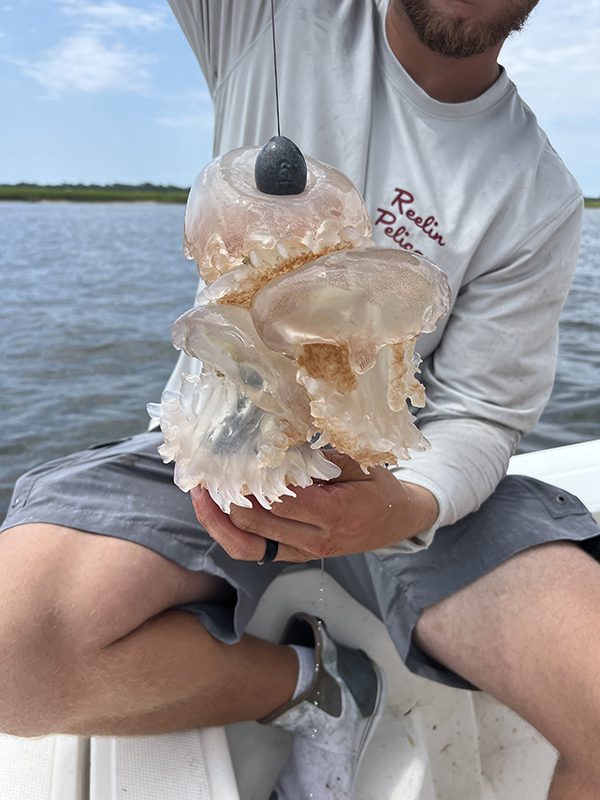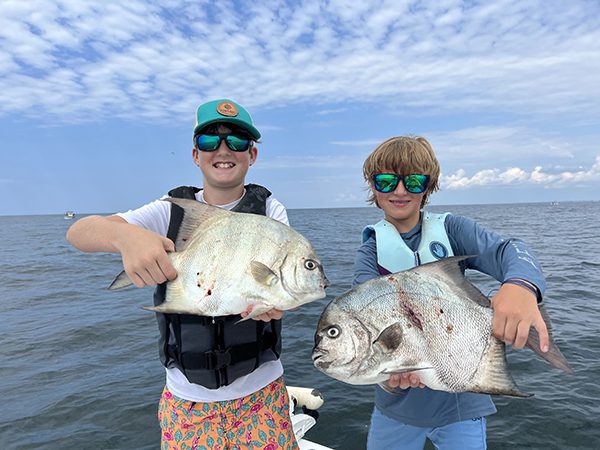Tidelines – August 2023
The chum rigger sitting on the bottom in about 30′ of water off of Oak Island started a subtle dance, just as Capt. Robert Capps of Reelin’ Pelican Fishing Charters had predicted, hopefully caused by the pecks of spadefish that had discovered the three cannonball jellyfish he had rigged only a couple of minutes ago.
Robert self-describes as a captain who loves to take kids fishing, in fact his marketing and promotional efforts state that he takes kids fishing for free, so it was an easy decision to invite Ethan (my 11-year-old) and his buddy Mason for a half day.
We came out of the Cape Fear River and took a right down the western bar channel. The ocean ride started a little bumpy due to the effects of the falling tide, but about one mile or so out of the current the seas laid flat and we began our search for cannonball jellyfish.
In 15-20’ of water, cannonball jellyfish were appearing with some regularity, so Robert pulled the boat back to idle and hopped up in the bow armed with his landing net and the trolling motor remote. Scooping jellyballs is a team effort, and the boys immediately embraced the task of spotting jellyballs and then yelling out directions to Robert in the form of “one at 1:00” and “two at 10:00 right by the boat.”
“Usually I find my jellyballs close to the beach,” Robert told me as he started slowly reeling and inching up the chum rigger through the water column, hoping the pecking activity would continue and soon we would see our target species following the cannonball jellies up to the surface. “Four’s a good number to get started. I put three of them on my chum rigger and keep one to cut up for bait.”

Capt. Robert Capps, of Reelin’ Pelican Charters, holds up the chum rigger he uses when targeting spadefish–three cannonball jellyfish on a wire with weight at the bottom (to get the rig down) and weight at the top (to hold the jellyballs together).
For the chum rigger, Robert often uses a wire clothes hanger, but today he was armed with a piece of 200 lb. wire. There’s about 16 oz. of lead on the bottom, and then he runs the wire from the bottom through the top of three cannonball jellyfish. At the top of the third jellyball, he adds another 6-8 oz. of lead to hold the three together.
The chum rigger is tied off to one of his heavier rods, and that heavier rod, sitting in a T-top rod holder, allows him to both drop the chum rigger to the bottom and reel it up at the desired pace to the surface.
“I drop it all the way to the bottom to start,” continued Robert, “and I hold the line so I can feel the line start bouncing. That’s the fish chewing on it, so I start to inch it up to the surface. I try to get the spadefish up as high as possible because then I can see them eat the baits, but some days they’re a little finicky and you have to keep them down to where you can just see them.”
Our day was not a finicky day. Soon Ethan, Mason, and I were leaning over the gunnel and seeing at least a dozen fish swirling under and around the cannonball jellies. They first came into view about 8’ down, but now Robert had the pack of fish right just under the water’s surface.
The terminal tackle he uses is simple—a #1 SSW needlepoint Owner hook (a little hook for small mouths) connected to the braid with 3-feet of 25 lb. fluorocarbon. Robert adds a couple of split shots to the leader, about 12″ up from the hook, and the weight and number of split shots vary with the amount of current. The goal is to generate a slow fall, one that presents as natural as possible, so your bait looks like a little piece of jellyball that’s fallen off of the chum that they’ve already been chewing on.
You don’t need to be a kid to get excited at the sight of multiple fish in a feeding frenzy. All three of us rushed to hook a small piece of shrimp onto our little hooks, and then we each flipped the bail and watched our baits slowly fall about two-feet down. The goal was to keep the baits right beside the chum rigger and in the fray.
“I don’t go to the jellyball as bait until I have to,” Robert explained as he continued to cut shrimp in small chunks to have at the ready. “Often shrimp can get them started better. If the bite slows, I’ll switch to jellyballs.”
The spadefish bite is a gentle, slight nudge. When you feel a small bump, you want to hit them with a quick, little hookset. Once hooked, though, gentle and slight don’t apply. Spadefish will dog it down, run some drag out, move around the boat, and get sideways to use their body shape (spadefish are a tall and wide fish) to put up a fun fight.
The shrimp worked as Robert predicted, with each of us hooking a couple of quick fish. Ethan, Mason, and I enjoyed the strong pull of a spadefish and seeing dinner come into the boat, but the bigger thrill came from watching our baits float among the fish and trying to guide our baits in front of the bigger fish in the pack.
When the bite slowed, Robert switched us over to using small cubes of jellyballs as bait, and the change in bait worked. When the bite slowed again, he dropped the chum rigger back down to the bottom to bring up a fresh group of fish, and that technique worked, too. Then when the bite slowed down a third time, we picked up and moved to a different rock.
Back at South Harbor Marina, Robert began cleaning and bagging our fish for the drive home, a service he provides for all of his clients. Ethan and Mason were only mildly interested in watching Robert clean fish, so Robert, a father himself and knowing how to successfully manage kids, asked if they’d be interested in grabbing some of the live pogies he had in the livewell and throwing them to the pelicans that were gathered in the water by the fillet table.

Ethan (left) and Mason with two of the spadefish they caught dropping pieces of shrimp and cubes of jellyballs to fish feeding just below the surface. They were fishing an AR off Oak Island with Capt. Robert Capps, of Reelin’ Pelican Charters.
Kids and live bait and bait nets and birds were all the distraction the boys needed for Robert and me to chat uninterrupted while he finished our fish.
With or without kids, it makes sense to schedule a spadefish trip with Capt. Robert Capps, of Reelin’ Pelican Charters out of the Southport/Oak Island area. These fish typically start in mid to late June and then stick around all summer, and you can reach Robert by visiting reelinpelican.com or by calling (910) 431-5341.
Robert suggests, if you want to try this trip on your own, that when you net a cannonball jellyfish, you put it directly in a 5-gallon bucket or some holder, as the colors of the jellyballs will stain your hands, your clothing, and your boat.
My suggestion? You hop on Robert’s boat and let him do the work to generate a day of memories and tasty fillets for you and whomever you decide to bring onboard.





